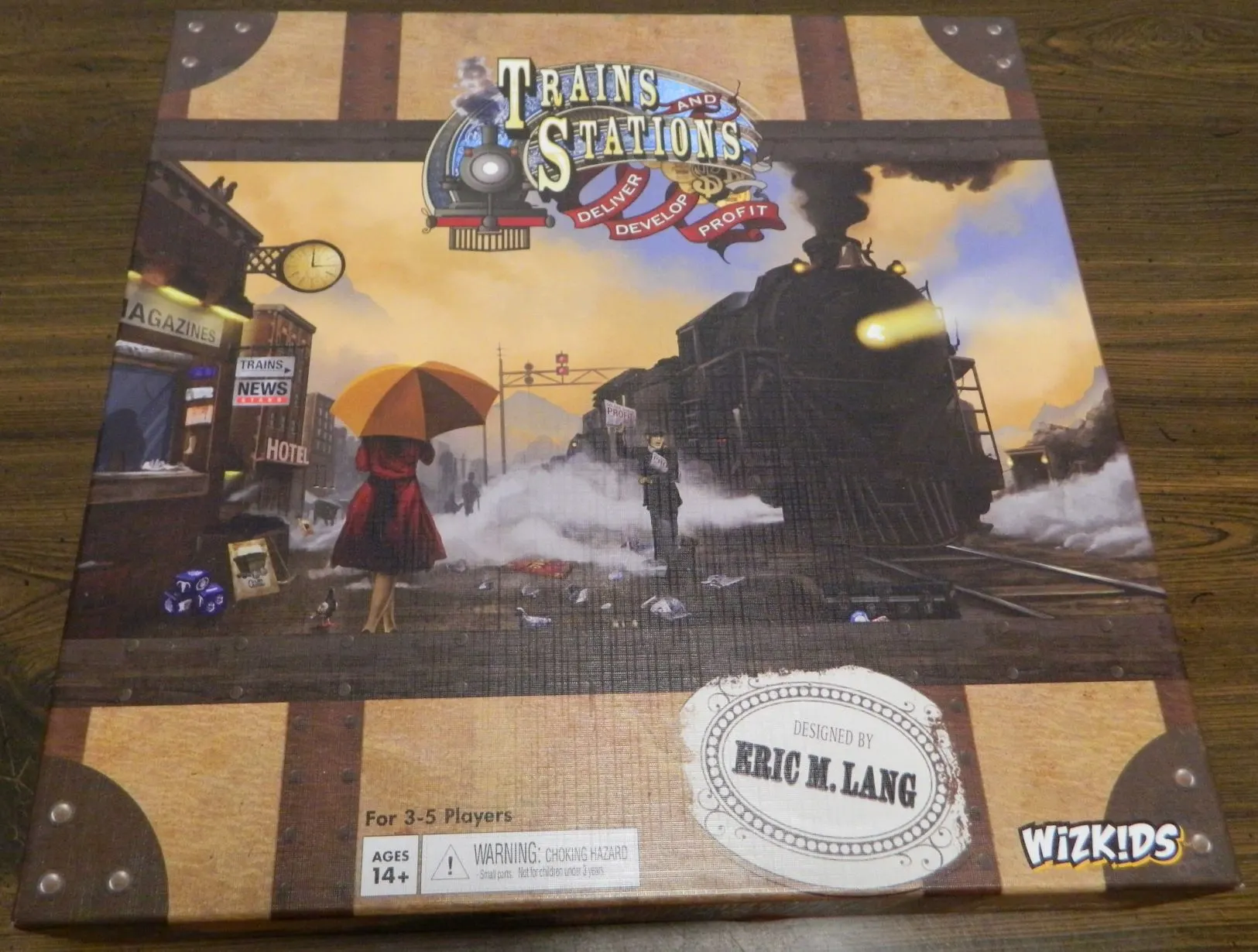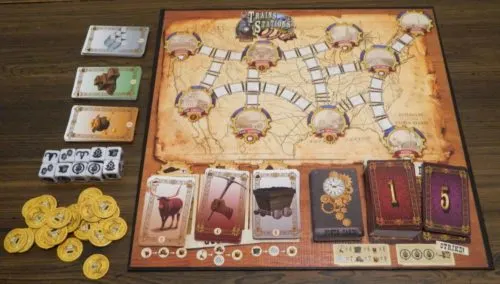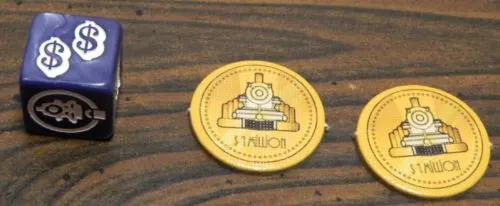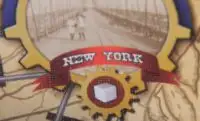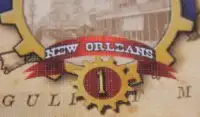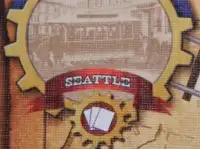Any regular reader of Geeky Hobbies will know that my favorite board game of all time is Ticket to Ride. Despite not really having any interest in trains in real life, I have always been kind of a sucker for board games based on trains. What I like about train board games is that creating connections between cities is surprisingly satisfying. As a fan of train games I am always interested in checking one out especially if it tries to do something original. This is why I was interested when I saw Trains and Stations as it seemed like a really interesting combination of different genres. The game has your typical train route building, but it also includes dice rolling along with some cooperative elements. This seemed like a really interesting combination of mechanics. Trains and Stations is a quick and easy game to play with some good ideas that don’t always work as well as I would have hoped.
How to Play Trains and Stations
Setup
- Place the game board in the middle of the table.
- Sort the goods cards by their type. To begin the game the cards are placed as follows:
- Cattle cards are placed on the ranch space.
- Worker cards (pickaxe) are placed on the hotel space.
- Coal cards are placed on the mine space.
- The food, silver and gold cards are set to the side of the board.
- Place the VP cards on the corresponding spaces. The number of cards you will use depends on the number of players:
- 5 players: Use all of the VP cards.
- 4 players: Return two of the 5 VP cards to the box.
- 3 players: Return four of the 5 VP cards to the box.
- Shuffle the power cards and deal three to each player face down. Each player will choose two of the cards to keep. Each player’s third card will be returned to the power card deck which will be reshuffled. This deck of cards will be placed face down on the power card space on the game board.
- Each player chooses a color. They will take all of the dice and buildings of their chosen color.
- All of the white dice are placed next to the game board.
- Each player is given three coins and three 1 VP cards. The rest of the coins are placed in the bank next to the gameboard.
- Choose who will be the first player. The game recommends that the last player to ride on a train should be the first player. The first player is given the Conductor’s Hat token to indicate that they were the first player.
Playing the Game
On a player’s turn they will take the following actions:
- Roll and Re-roll Dice
- Resolve Dice Rolls
- Make Deliveries
- End Your Turn
Rolling Dice
At the beginning of each turn players will choose which dice they will roll on their turn. A player may roll a max of five dice of their color. If they have less than five dice of their color they may roll less. A player may only roll dice that aren’t already on the game board. If you saved any dice from your previous turn you will use these as some of your five dice. Make sure you keep saved dice on the side that was originally rolled. The rest of the five dice come from your color dice that you have held in reserve.
On previous turns you may have also acquired bonus dice (white). These dice can be rolled in addition to your five color dice. You can choose to roll all of them, none of them, or just some of them. If you have less than five of your color dice though you must use at least enough bonus dice (if you have them) in order to roll at least five dice on your turn. Also if there are no bonus dice available in the bonus dice pool you must roll all of your bonus dice.
If a player has five or more of their dice on the game board they can choose to reclaim all of the dice from the game board. If they choose this option they will lose the rest of their turn.
Once a player has gathered all of the dice they will roll them. Instead of being rolled any dice that were saved from the previous turn can remain on their current side. The player can also choose to roll these dice as well.
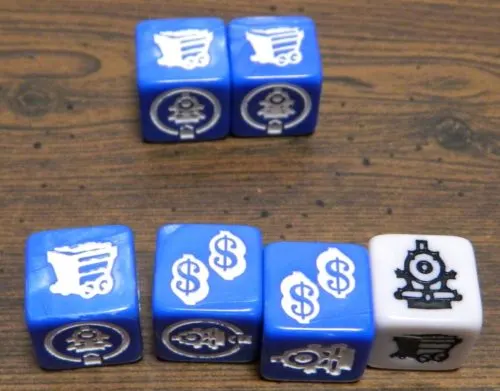
These are the dice that the blue player will roll this turn. The two dice at the top were kept from the previous turn. The player can choose to keep them as mine carts or roll them again. The other three blue dice are taken from the player’s supply. The blue player also chose to roll one of their bonus dice.
After a player rolls the dice if they want to re-roll any of their dice they will have to spend one coin. After spending the coin they can re-roll as many of their dice as they want except for dice that landed on the locked train side. After re-rolling if you want to re-roll dice again you can pay another coin. You can do this as many times as you want as long as you have coins and don’t roll three locked trains.
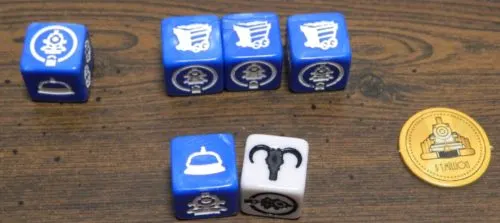
After their first roll the player has these symbols. They must keep the locked train symbol in the top left corner. They have decided to keep the three mine carts so they can build a mine. The player wants to re-roll the two bottom dice though so they will pay one coin to do so.
If you roll three or more locked trains your workers will go on strike. When your workers go on strike you can no longer reroll your dice. You will also lose 3 VP. If you have less than 3 VP you will lose all of your VP.
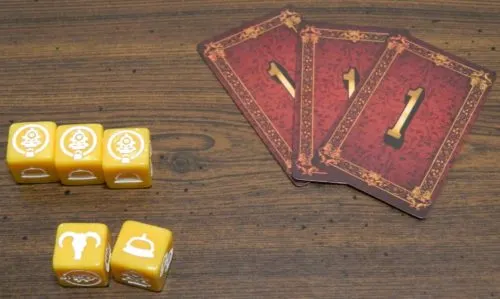
This player rolled three locked train symbols triggering a strike. Thus the player will lose three victory points.
Resolve Dice Rolls
After you have finished rolling the dice you will resolve the symbols you rolled.
Train Dice
Any train or locked train symbol you rolled will be placed on one of the spaces on the gameboard. These dice can be placed on any unoccupied space next to a station or next to another die already placed on the gameboard. If placing these dice fills in all of the spaces between two or more stations the route will be completed and a delivery will be made (see below).
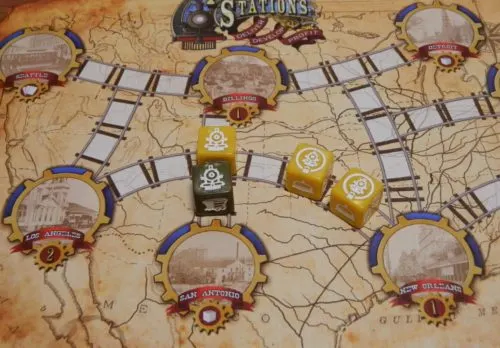
The yellow player rolled three train symbols. They played their first die next to New Orleans. They played another die next to the first die they played. Finally they played a die next to the green die that was already on the board.
Buildings
When a player rolls three or more building symbols of the same type they will get to place one of the corresponding buildings on one of the stations on the game board. If a player doesn’t have any of the buildings left this action will do nothing for them.

The green player rolled three cattle symbols so they will get to place a ranch. The yellow player rolled three bells so they will get to place a hotel. The red player rolled three mine carts so they will get to place a mine.
After you have placed the building the three dice will be returned to their pool. Your color dice will return to your pool and the white dice will return to the bonus dice pool.
When placing a building you must follow two rules.
- Each station only supports two or three buildings. This is indicated by the blue spaces around the station name. Only one building may be placed on each blue space. Once all of the blue spaces are filled no more buildings can be added to the station.
- Players may not place a second building on a station until all of the stations have one building. A third building may not be placed on a station until all of the stations have two buildings.
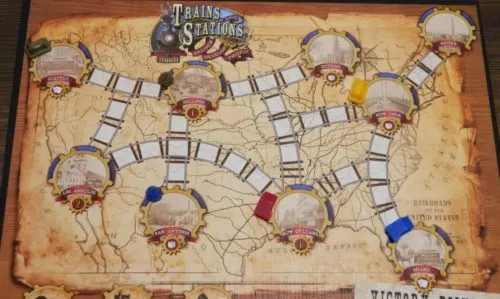
So far a number of buildings have already been placed on the board. The next building that is added has to be added to Los Angeles, Detroit, or Boston as the rest of the stations already have a building. In total a city like San Antonio can only have two total buildings placed on it due to the blue marks around the sides of the station. Meanwhile Los Angeles can have a total of three buildings.
Coins
For each coin that is rolled the player will take two coins from the bank. Players can only have a max of five coins at any time.
Saving Dice
Any of your color dice that show a building or a coin can be saved for your next turn. Train, locked train, and bonus dice may not be saved for a future turn. When a player saves a dice they will set it aside making sure it stays on the same side that was rolled.
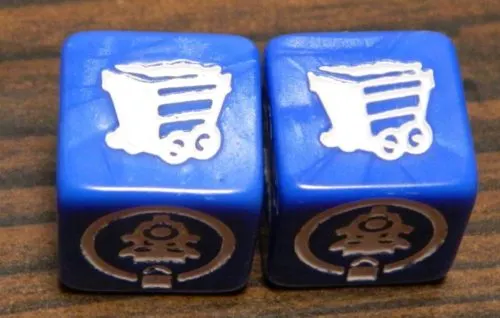
This player rolled two mine carts. As they want to place a mine they have decided to keep the two dice for their next turn.
Delivery
When all of the spaces between two or more stations are filled with dice there will be a delivery of goods. All of the cities connected together in the route will be part of the delivery. If multiple deliveries are made on the same turn the current player will choose the order in which they are made.
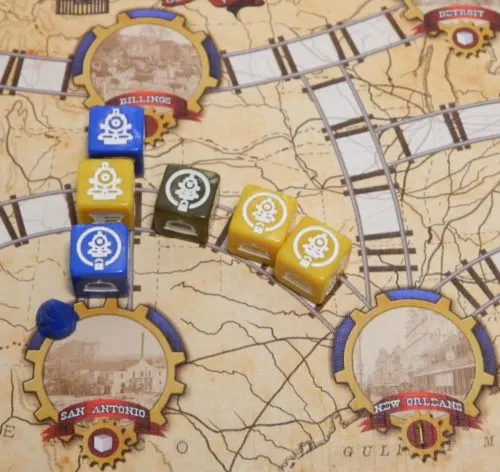
All of the spaces have been filled in between Billings, San Antonio, and New Orleans. Thus a delivery will be made between these three cities.
To perform a delivery follow these steps:
#1 Completion VPs
Every player that added at least one of their color dice to the route will receive one VP for each city that was part of the route. Bonus dice played by a player do not count for these victory points.
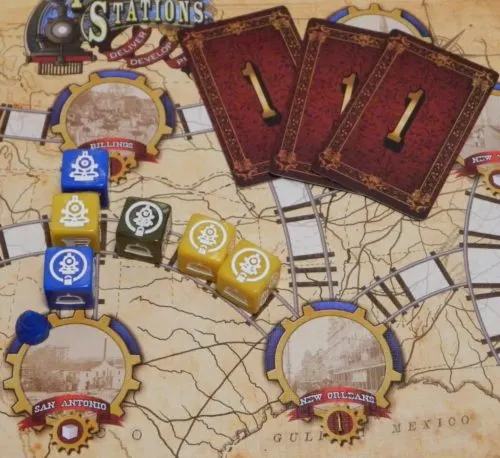
This route connects three different cities. The yellow, green and blue players will all receive three VP cards.
#2 Majority Bonus
Each station on the board has an associated bonus that is activated when a delivery is made to the city. These bonuses are as follows:
- This cube symbol indicates that the player with the majority will get to take a bonus dice.
- The number symbol means that the player who receives the majority bonus will receive one VP card.
- This card symbol indicates that the player with the majority bonus will receive a power card.
Count up how many of each color of dice make up the route. The player who played the most of their color dice (does not include bonus dice) to the route will receive the majority bonus for this route. If two or more players are tied for the majority bonus the current player will get to break the tie. For the majority bonus the majority player will receive the bonus for each of the connected cities. These bonuses could include VP, a power card or a bonus dice. If a bonus is not available the player will not receive the corresponding bonus.
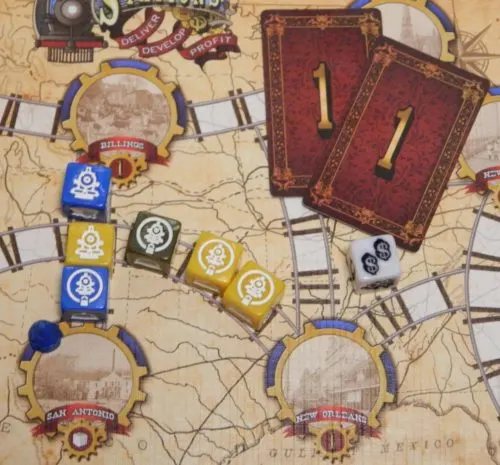
The yellow player has the most dice in this route so they will receive the majority bonus. They will receive two VP (Billings and New Orleans) and a bonus dice (San Antonio).
#3 Collect Goods
Players will look at the connected stations to see what buildings are on them. For each building on one of the connected stations the corresponding player will take one card from the corresponding section of the gameboard. Players will place these cards face down in front of themselves. Players can look at these cards at any time, but they shouldn’t show them to the other players. If all of the cards from a specific building type run out the current player determines the order that players will take cards. Any player(s) that aren’t able to take the corresponding goods card will get 1 VP instead.
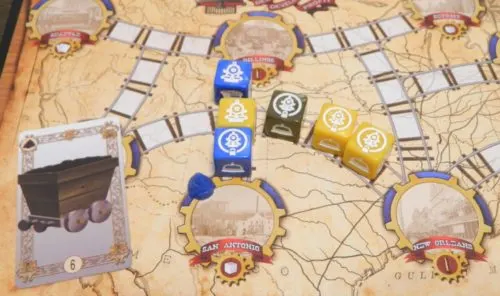
The blue player had a mine on San Antonio which was one of the cities that was part of the completed route. They will get to take a coal card due to their mine.
#4 Completing Missions
At this point players look through their power cards. If they have a mission card that matches the route that was completed they can play the card in front of them. This card will count for the corresponding number of VPs at the end of the game (do not take VP cards corresponding to the amount). A player may play one of these cards even if none of their own color dice were in the route. A player may not play more than one mission card each turn though. If a player has two or more of the same mission cards they may only play one of them. They will have to wait for the route to be completed again in order to play the other card. If a player doesn’t play the card at this point they cannot play it at a later time.
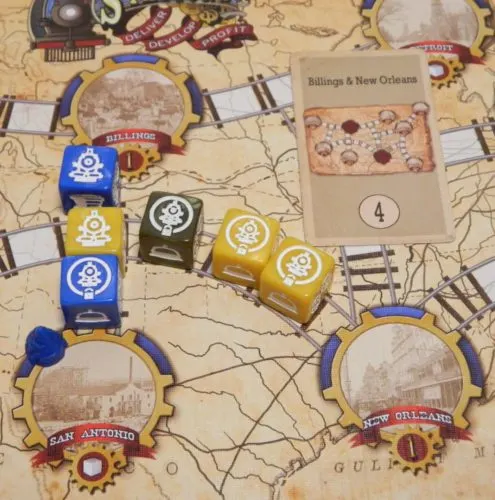
This player had a mission card of trying to connect Billings and New Orleans. As that route was completed the player can play this card face up in front of themselves. This card will be worth four points at the end of the game.
#5 Reclaim Dice
All dice from the completed route are removed from the board. Each player takes back their own colored dice. Any bonus dice are returned to the bonus dice pool.
End of Turn
Before a player ends their turn they must check the three goods card spaces on the game board. If one or more of the spaces have no cards on them the player will replace them with another deck. If there are two or three spaces without cards only one will receive new cards. The other(s) will receive cards at the end of the next player’s turn. The current player will determine which space will receive cards.
To determine what set of cards will be placed on the space next look at the icons beneath the space. Place the cards corresponding to the next symbol on the space. If those cards are already on another space skip to the next symbol. When choosing the next set of cards for the hotel the current player will get to choose either the silver or food. After the food or silver the hotel will move onto the gold cards.
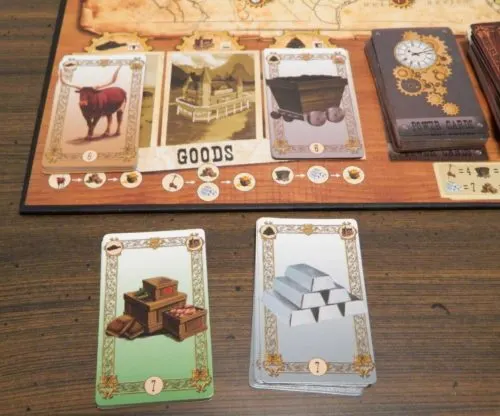
The hotel has run out of workers. To fill in the empty space either the food or silver cards will be placed on the space.
If there are no more sets of cards to add to a space that building space will no longer give out goods cards for the rest of the game.
If a new set of cards are added to a building space all of the players will get the opportunity to immediately buy some of the goods. In secret each player can exchange two of their goods cards of any type for one card of the new type. Players can make as many exchanges as they want and the two goods traded in don’t have to be of the same type. Some of the bonus cards also feature goods. You can use one of these cards to buy goods and it will count as two goods for the trade.
When everyone is ready all of the players will reveal how many cards that they will trade in. Players will take the corresponding number of cards of the new good and discard the cards that they traded in. If players buy more of the good than are available the space will remain open until the next player’s turn. The current player will get to determine who will get the goods cards. The extra bought cards will be replaced with 1 VP cards.

The silver cards have been added to the board so players have the opportunity to buy them. This player traded in a bonus card featuring two goods cards along with two cattle cards. These cards will be exchanged for two silver cards.
End of Game
Once all of the VP cards have been taken the game will enter the endgame. Players will keep taking turns until play returns to the player with the Conductor token (they don’t get another turn) so all of the players get the same number of tokens. If players earn VP at this point they will still earn those points. You can use the VP cards not used in the game for this purpose.
Players will then tally up their scores. Players will score points equal to all of their VP cards and the mission cards they completed during the game. Coins are worth no victory points at the end of the game.

This player received 18 points from their victory point cards. They will receive an additional ten points from the two mission cards they completed.
Players will then compare who has the most cards of each goods type. If two or more players tie for the most cards they will both score the associated points. The player with the most cards of each type will score points as follows:
- Workers: 4 points
- Coal: 6 points
- Cattle: 6 points
- Silver: 7 points
- Food: 7 points
- Gold: 9 points
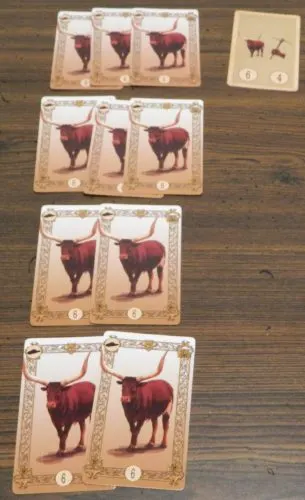
The top player collected three cattle cards and cattle are featured on a power card giving them a total of four cattle. The other players have three, two, and two cattle respectively. As the top player had the most cattle they will receive the six points from cattle.
The player with the most victory points wins the game. If there is a tie the tied player with the most gold will win the game. If it is still a tie the tied players will share the victory.
My Thoughts on Trains and Stations
Trains and Stations is interesting in that it feels like a combination of quite a few other board game mechanics. The most obvious mechanic is the route building mechanic as you add dice to the board to complete routes between cities. There is some tweaks to this mechanic, but it is still very similar to Ticket to Ride and other train games as it even includes the secret ticket cards that score you bonus points if you are able to connect two specific cities together. The twist on this mechanic comes from the fact that all of the players can work together in order to complete a route and share in the rewards. Once a route is completed all of the dice are also removed from the board which allows players to keep completing the same routes over and over again.
This addition of a semi-cooperative mechanic to a traditional route building mechanic is actually quite interesting. Just adding one dice to a route will entitle you to some of the rewards even if the other players played a majority of the dice. This adds a interesting element to the game as adding dice to a route helps other players complete it, but it also allows you to mooch off the other player(s) work. You could add one die to a route while another player adds three or more dice and you will both receive the same VP reward for completing the route. They will receive the majority bonus, but you can mitigate their gains just by adding one dice in the right position. As scoring points for completing routes is one of the best ways to score points in the game, mooching off other player’s routes is a totally valid strategy in Trains and Stations.
What really differentiates Trains and Stations from your typical train game though is that your actions in the game are dictated by rolling dice. Instead of getting a choice of what actions you want to take on your turn, the symbols you roll will determine what you can do. Any trains you roll are used to help finish routes. If you roll three of the same symbol you can add a building to the board which will get you resource cards. You can turn money symbols into coins which lets you re-roll dice in order to try and get a different combination. You can even keep symbols in order to use them on your next turn.
Probably the most impactful mechanic other than route building is getting your buildings out onto the map. Whenever possible you probably want to place one of your buildings as you will receive passive rewards from players completing routes that feature one of your buildings. These buildings give you goods cards which is one of the best late game sources for victory points. The player with the most goods of each type of good will score you bonus points. You also need to focus on helping to complete routes, but having the majority of a type of resource is a good bonus to your score at the end of the game. As players have no idea what resources the other players currently hold in their hands this adds somewhat of a risk reward mechanic as you try to read the other players to figure out how many cards they have of each resource.
With all of these different mechanics Trains and Stations may seem like it would be a somewhat complicated game. I think this is one of the game’s greatest strengths though. The game is more complicated than a majority of mainstream games, but it is not particularly complicated for anyone who has ever played a game beyond the level of a game like Monopoly. I would say that the difficulty is on par with a game like Ticket to Ride. The mechanics are really straightforward. The only somewhat complicated mechanic comes from when you complete a route and when a new type of goods comes into play. Neither of these mechanics are all that complicated either. Basically I think you could teach the game to most players within five to ten minutes.
For this type of game I was also kind of surprised that the game was shorter than I expected. Many games in these genres take around an hour or so to complete. Trains and Stations is a game that takes closer to 30-45 minutes. As long as none of the players suffer from analysis paralysis the game plays pretty quickly. This is mostly because while you have options they are usually either determined for you or are pretty obvious where you don’t have to waste a bunch of time figuring out what you want to do. Unless you have a lot of coins to re-roll dice your options are mostly decided based on what you roll. You then need to decide how you want to use those dice. In general I like that the game is on the shorter side. This will allow the game to appeal to more players that aren’t too keen on playing an hour plus game.
The problem with the length is that it feels like the game ends kind of abruptly. You are just starting to ramp up your strategy and then the game ends. This prevents you from completing a deep strategy. Instead you are better off adapting to whatever you end up rolling as you likely won’t have the time to complete a long drawn out strategy. I think this can be emphasized by the fact that the goods mechanic doesn’t seem to ever get off the ground. The game includes a total of six different types of goods. Three are in play right away while the other three get added when the other goods cards are all taken. The problem is that you won’t get through many of these merchandise cards. In one game we literally only got through one of the merchandise decks and that only happened on the very last turn. This seems like it happens quite often as it is hard to collect a lot of goods cards in the game.
I think this is due to the fact that you are usually best off trying to complete as many deliveries as possible as they seem like the best source of victory points. In particular players can complete the same routes over and over again. These routes only include three train dice which means you can complete them in one turn. This leads to the VP point piles running out of cards quickly which then ends the game. I honestly think the game could use some house rules allowing for more buildings to get added to the board so more goods cards are taken before the game ends. This lack of goods cards hurts this scoring option. The first three types of goods cards may have some competition for the majority, but the other goods will likely come down to whoever is lucky to get one or two of the good. A player could literally win one of the more valuable goods just because they got a bonus card featuring a good that never got put out. This could lead them to getting quite a few free points.
In addition to this the game relies on quite a bit of luck. The game has some strategy as you need to use your dice well and choose the right time to re-roll dice. What you roll ultimately determines what actions you can take though. You might have a great strategy, but what difference does it make if you don’t roll the right symbols. All of the sides of the dice have their own uses so no dice roll is a complete waste. The key to the luck in the game though is to roll the right symbols at the right times. Players that are able to roll the symbols that they need at the right times are going to have a significant advantage in the game. Strategy is important in Trains and Stations, but this reliance on luck does reduce how much of a role that strategy plays.
For the most part I liked Trains and Stations’ components. I like the game’s art style as it works well for the game. Even though I think the game should have maybe come with more dice I liked the quality of them. I always appreciate when the symbols are engraved in dice since it prevents them from fading as quickly. I also thought the buildings actually show quite a bit of detail. The biggest problem with the components is that I think some of them are just too small. The gameboard is considerably smaller than you would expect as it probably should have been at least 50% larger. The buildings are also quite tiny and should have been bigger. I ultimately thought the components were pretty good though.
Should You Buy Trains and Stations?
Trains and Stations is a good game but it does have a few issues. I think the game deserves credit for doing a good job combining mechanics from a couple different genres. Adding a dice rolling and a semi-cooperative mechanic to a typical train game was an interesting idea that works pretty well. The game gives you strategic choices which impact your fate in the game. These lead to a fun game that plays quickly that can be enjoyed by most players. The length leads to arguably the game’s biggest problem though as it seems to end before you can pull off any significant strategy. Like most dice rolling games it also relies on quite a bit of luck as what you roll determines what you are able to do. Ultimately Trains and Stations is a good not great game that I had fun playing.
My recommendation comes down to your opinion of the game’s premise. If the idea of combining a dice game with a train game doesn’t sound all that interesting it probably won’t be for you. People who enjoy train and dice rolling games though should have enough fun with Trains and Stations. For the right price I think it is worth picking up Trains and Stations.

